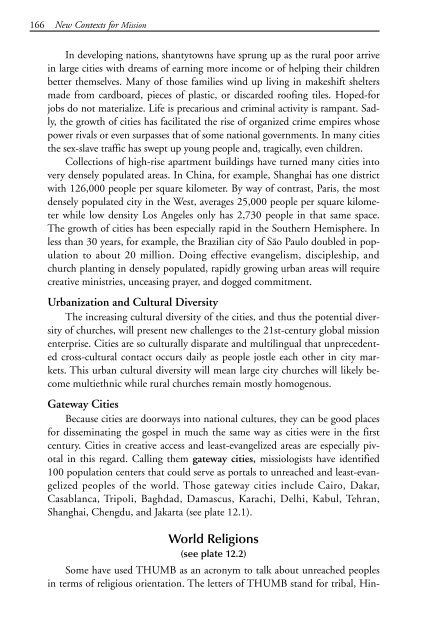discovering missions - Southern Nazarene University
discovering missions - Southern Nazarene University
discovering missions - Southern Nazarene University
You also want an ePaper? Increase the reach of your titles
YUMPU automatically turns print PDFs into web optimized ePapers that Google loves.
245187 Disc Missions ins 9/6/07 1:04 PM Page 166<br />
166 New Contexts for Mission<br />
In developing nations, shantytowns have sprung up as the rural poor arrive<br />
in large cities with dreams of earning more income or of helping their children<br />
better themselves. Many of those families wind up living in makeshift shelters<br />
made from cardboard, pieces of plastic, or discarded roofing tiles. Hoped-for<br />
jobs do not materialize. Life is precarious and criminal activity is rampant. Sadly,<br />
the growth of cities has facilitated the rise of organized crime empires whose<br />
power rivals or even surpasses that of some national governments. In many cities<br />
the sex-slave traffic has swept up young people and, tragically, even children.<br />
Collections of high-rise apartment buildings have turned many cities into<br />
very densely populated areas. In China, for example, Shanghai has one district<br />
with 126,000 people per square kilometer. By way of contrast, Paris, the most<br />
densely populated city in the West, averages 25,000 people per square kilometer<br />
while low density Los Angeles only has 2,730 people in that same space.<br />
The growth of cities has been especially rapid in the <strong>Southern</strong> Hemisphere. In<br />
less than 30 years, for example, the Brazilian city of São Paulo doubled in population<br />
to about 20 million. Doing effective evangelism, discipleship, and<br />
church planting in densely populated, rapidly growing urban areas will require<br />
creative ministries, unceasing prayer, and dogged commitment.<br />
Urbanization and Cultural Diversity<br />
The increasing cultural diversity of the cities, and thus the potential diversity<br />
of churches, will present new challenges to the 21st-century global mission<br />
enterprise. Cities are so culturally disparate and multilingual that unprecedented<br />
cross-cultural contact occurs daily as people jostle each other in city markets.<br />
This urban cultural diversity will mean large city churches will likely become<br />
multiethnic while rural churches remain mostly homogenous.<br />
Gateway Cities<br />
Because cities are doorways into national cultures, they can be good places<br />
for disseminating the gospel in much the same way as cities were in the first<br />
century. Cities in creative access and least-evangelized areas are especially pivotal<br />
in this regard. Calling them gateway cities, missiologists have identified<br />
100 population centers that could serve as portals to unreached and least-evangelized<br />
peoples of the world. Those gateway cities include Cairo, Dakar,<br />
Casablanca, Tripoli, Baghdad, Damascus, Karachi, Delhi, Kabul, Tehran,<br />
Shanghai, Chengdu, and Jakarta (see plate 12.1).<br />
World Religions<br />
(see plate 12.2)<br />
Some have used THUMB as an acronym to talk about unreached peoples<br />
in terms of religious orientation. The letters of THUMB stand for tribal, Hin-

















